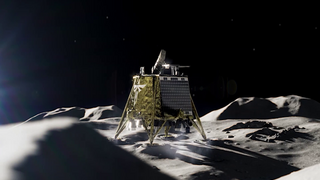NASA Interview Opportunities: Two Moon Deliveries with NASA Instruments Days from Landing

Associated cut b-roll will be added by 5 p.m. EST on Thursday, Feb. 27.
Quick Summary:
Two commercial companies are delivering NASA science and technology to different locations on the Moon.
Firefly Aerospace’s Blue Ghost Mission 1 launched Jan. 15, and is set to land on Sunday, March 2, near a volcanic feature called Mare Crisium located in the northeast region of the Moon’s near side.
Intuitive Machines launched its IM-2 mission on Wednesday, Feb 26., and is targeted to land approximately eight days later in a plateau near the Moon’s South Pole.
Science and technology deliveries to the Moon are helping to pave the way for sustainable human exploration at the Moon through NASA’s Artemis campaign.
Interview Details:
Live and taped interviews are available on Friday, Feb 28 between 6 a.m. - 1 p.m. EST
Click here to request an interview:https://forms.gle/EyVJsqvwrigqEjfn8
Requests sent via the above form will have scheduling priority
Please do not email requests.
All eyes on the Moon! We are days away from not one – but two – deliveries of scientific investigations and technology demonstrations to different regions of our nearest celestial neighbor.
The deliveries are part of NASA's CLPS (Commerical Lunar Payload Services) initiative, which works with American companies to deliver NASA hardware to the Moon’s surface. Like a rideshare here on Earth, the CLPS initiative is a cost-effective and efficient way to get NASA science experiments and technology demonstrations to the lunar surface for the benefit of all.
Rapid and regular CLPS deliveries offer opportunities to test, refine, and learn from technologies that will be needed for future complex operations on the Moon. These commercial missions where NASA is one of many customers, are pushing the boundaries of what's possible on the lunar surface and paving the way for future astronauts to live and work on the Moon, and beyond on Mars. The rarity of having two landers operating on the Moon at the same time in different locations makes these deliveries especially exciting.
Firefly Aerospace’s Blue Ghost Mission 1 will land on Sunday, March 2, in a mountainous region within an ancient volcanic basin called Mare Crisium, located in the northeastern region of the Moon’s near side. The lander is carrying 10 different NASA science and technology payloads that will test and demonstrate lunar drilling technology, capabilities for collecting regolith (lunar rocks and soil) samples, global navigation satellite system abilities, radiation tolerant computing, and lunar dust mitigation methods. The data captured could also benefit humans on Earth by providing insights into how space weather and other cosmic forces impact our home planet.
Intuitive Machines’ IM-2 mission launched Wednesday, Feb. 26, and land approximately eight days later. The lunar South Pole is of particular interest to scientists because it is believed to contain volatiles or gasses that easily evaporate such as water and oxygen, which may be a valuable resource for future astronauts who will build a sustained presence on the Moon with NASA’s Artemis campaign. It will deliver a drill and mass spectrometer to measure the potential presence of volatiles or gases from lunar soil, as well as a demonstration of a robust surface communications system and a propulsive drone that can hop across the lunar surface.
NASA’s CLPS initiative is a one stop, all-inclusive delivery service to the Moon – where the agency is just one of many customers for the journey. By investing in commercial delivery services to the Moon, NASA is enabling industry growth and supporting long-term exploration of the Moon.
Suggested anchor intro:
We are just days away from not one – but two – deliveries to the Moon, packed with cutting-edge scientific investigations and innovative technologies that will shed new light on our nearest neighbor and expand the U.S.’s robotic presence on the Moon. Joining us now is XXX to talk about the upcoming pair of Moon landings, and the new NASA hardware making its way there.
Suggested questions:
1. This is an exciting time for lunar exploration with two deliveries filled with science and technology just days from touching down. Can you talk about how NASA is investing in American companies to support a growing lunar economy?
2. These landers are going to very different parts of the Moon – one to a mountainous area in an ancient volcanic basin on the near side and the other to a plateau near the Moon’s south pole. What is the value of exploring different locations on the Moon and the different data you want to collect from these locations?
3. Are you able to highlight some of the science and technology instruments these landers are carrying?
4. Regular, cost-effective deliveries of NASA instruments to the lunar surface will be a game-changer and improve access to the Moon for scientists and future astronauts. What can we expect?
5. Where can our viewers go to watch these two landings, and learn more about our future lunar exploration?
Cut associated b-roll for the live shots. TRT 6:32. No audio.
B-roll is separated by a slate with the associated question. Material answers the following questions:
1. This is an exciting time for lunar exploration with two deliveries filled with science and technology just days from touching down. Can you talk about how NASA is investing in American companies to support a growing lunar economy?
2. These landers are going to very different parts of the Moon – one to a mountainous area in an ancient volcanic basin on the near side and the other to a plateau near the Moon’s south pole. What is the value of exploring different locations on the Moon and the different data you want to collect from these locations?
3. Are you able to highlight some of the science and technology instruments these landers are carrying?
4. Regular, cost-effective deliveries of NASA instruments to the lunar surface will be a game-changer and improve access to the Moon for scientists and future astronauts. What can we expect?
5. Where can our viewers go to watch these two landings, and learn more about our future lunar exploration?
Additional questions:
1. The South Pole of the Moon is an interesting region with its permanently shadowed craters that may contain frozen water. What is the importance of understanding this region for future human exploration through NASA’s Artemis campaign?
2. NASA has been studying the Moon with the Lunar Reconnaissance Orbiter for almost 16 years. What are some of the most surprising things we’ve learned about our Moon?
3. In the early morning hours of Friday, March 14, (PI day) our Moon will turn red during a total lunar eclipse. How does this happen and what can we expect to see?
5. What areas of the Moon did the Apollo astronauts explore?
Cut b-roll for Firefly Aerospace SME. TRT: 4:28. No audio.
B-roll is separated by a slate with the associated question. Material goes with the following questions:
This is an exciting time for lunar exploration with two deliveries filled with science and technology just days from touching down. Firefly Aerospace’s Blue Ghost Mission 1 launched on Jan. 15 and will be landing soon on the lunar surface. Can you tell us more about this mission?
Can you talk about the mountainous area where Blue Ghost Mission 1 will land on the near side of the Moon?
Are you able to highlight some of the science and technology instruments this lander is carrying?
What are some of the challenges of landing a spacecraft on the Moon and how has Firefly prepared to overcome them? You took the scenic route to the Moon with a 45-day transit. Can you tell us more about why that route was chosen?
B-roll pkg for Intuitive Machines SME. TRT 3:55. No audio. Graphics are separated by a slate with the associated question.
B-roll goes with the following questions:
Intuitive Machines’ IM-2 mission launched on Feb. 26 and has begun the nearly eight day journey to the Moon. Can you describe what we can expect during transit?
Can you talk about the area where Intuitive Machines' IM-2 will be landing near the Moon's south pole?
What can we expect after lunar touchdown? How long will it take to get data back to Earth?
The Athena lander will be carrying a new type of lunar explorer, a hopper named "Gracie" designed to hop around on the Moon, Tell us more about this hopper and where it'll be going?
Last year Intuitive Machines landed on the Moon but did not land in an upright position. Can you talk about some of the lessons learned from that mission?
Pre recorded interview with Dr. Joel Kearns / Deputy Associate Administrator for Exploration. TRT: 7:48
For More Information
Credits
Please give credit for this item to:
NASA's Goddard Space Flight Center
-
Producers
- Michelle Handleman (eMITS)
- Alexa Figueroa (NASA Interns)
- Angel Kumari (NASA/GSFC)
-
Technical support
- Aaron E. Lepsch (ADNET Systems, Inc.)
Release date
This page was originally published on Tuesday, February 25, 2025.
This page was last updated on Friday, February 28, 2025 at 2:22 PM EST.

![Watch this video on the NASA Goddard YouTube channel.Complete transcript available.Music credit: "Breakthrough Discovery" by Phillip John Gregory [PRS] from Universal Production Music](/vis/a010000/a014700/a014739/Thumbnail01.jpg)
